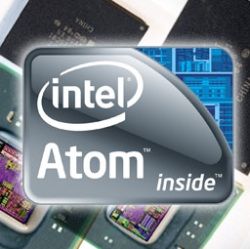5 Things You Need to Know About Intel's Atom N450 Processor

After much hype and speculation, Intel has finally announced the availability of its next-generation netbook platform, the Atom N450, code named Pine Trail. Netbooks powered by the N450 platform will be hitting the market soon, including the ASUS Eee PC 1005PE-P, Dell Inspiron Mini 10, and MSI Wind U135. But what exactly is the Atom N450 and what improvements does it offer?
1. It's Highly Integrated
The N450 is the first platform from Intel that integrates the graphics and memory controller in the processor. So instead of having three chips (CPU, chipset, I/O controller hub), it's now down to two (CPU and chipset). This has myriad benefits for both netbook makers and owners, which we'll explain.
2. Expect More Battery Life
Intel claims that the N450's power consumption has decreased 20 percent over the previous generation. In our early tests, we've seen a marked improvement. For example, the ASUS Eee PC 1005PE's six-cell battery lasted over 10.5 hours on a single charge, which is more than enough endurance for all-day computing. The earlier 1005HA had a very similar design, and lasted about 9 hours. When you add it up, you're talking about an 18.4 percent increase, which is pretty much in line with Intel's claims. What's interesting about the N450 is that it could last about 4 to 5 hours on netbooks with three-cell batteries, allowing consumers to potentially get decent endurance without splurging for a six-cell netbook.
3. Sleeker, Lighter Designs
Because the N450 integrates the memory controller and graphics into the CPU, Intel says that the total footprint for its netbook platform has shrunk by 60 percent. This means mini-notebook makers can create thinner and lighter designs, as well as make machines with smaller and quieter fans. You'll also find designs with batteries that don't protrude as much—if at all. For example, the new Dell Inspiron Mini 10 neatly integrates its six-cell battery with the chassis for a unified look.
Stay in the know with Laptop Mag
Get our in-depth reviews, helpful tips, great deals, and the biggest news stories delivered to your inbox.
4. Similar Performance, and No Dual Core (for Now)
Given that the N450 runs at the same clock speed as the N280, 1.66-GHz, we weren't expecting much of a speed boost. And sure enough, the first Atom N450 netbook we tested, the ASUS Eee PC 1005PE, turned in scores that were on a par with older Atom machines. In PCMark05, which measures Windows performance, the system was a bit below average but ahead of the curve in another synthetic benchmark, Geekbench. If you thought Intel was bringing dual-core muscle to Atom netbooks, think again. For now, dual-core Atom CPUs are reserved for compact desktop PCs, although that's not stopping the likes of ASUS from taking these chips and cramming them into 12-inch machines like the Eee PC 1201N.
5. Bring Your Own Graphics Muscle
Atom-powered netbooks have new Intel GMA 3150 graphics, which replaces the GMA 950 chip. As mentioned above, the 3150 is integrated with the CPU, but in our early tests we haven't seen a performance boost. So if you want graphics muscle from your netbook, especially for full-screen video streaming on sites like Hulu and YouTube, you'll want to consider a video accelerator from Broadcom (available on the new Dell Inpsiron Mini 10 and soon other netbooks). Systems equipped with Nvidia's Ion graphics (such as the HP Mini 311 and Lenovo IdeaPad S12) go further by allowing users to play mainstream 3D games and even edit video faster, but you'll pay more for those systems.
